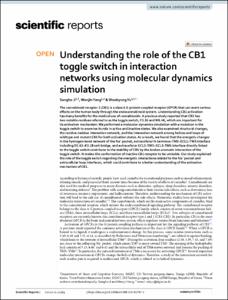Full metadata record
| DC Field | Value | Language |
|---|---|---|
| dc.contributor.author | Ji, Sangho | - |
| dc.contributor.author | Yang, Wonjin | - |
| dc.contributor.author | Yu, Wookyung | - |
| dc.date.accessioned | 2021-11-25T08:00:06Z | - |
| dc.date.available | 2021-11-25T08:00:06Z | - |
| dc.date.created | 2021-11-18 | - |
| dc.date.issued | 2021-11 | - |
| dc.identifier.issn | 2045-2322 | - |
| dc.identifier.uri | http://hdl.handle.net/20.500.11750/15861 | - |
| dc.description.abstract | The cannabinoid receptor 1 (CB1) is a class A G-protein coupled receptor (GPCR) that can exert various effects on the human body through the endocannabinoid system. Understanding CB1 activation has many benefits for the medical use of cannabinoids. A previous study reported that CB1 has two notable residues referred to as the toggle switch, F3.36 and W6.48, which are important for its activation mechanism. We performed a molecular dynamics simulation with a mutation in the toggle switch to examine its role in active and inactive states. We also examined structural changes, the residue–residue interaction network, and the interaction network among helices and loops of wildtype and mutant CB1 for both activation states. As a result, we found that the energetic changes in the hydrogen-bond network of the Na+ pocket, extracellular N-terminus–TM2–ECL1–TM3 interface including D2.63–K3.28 salt-bridge, and extracellular ECL2–TM5–ECL3–TM6 interface directly linked to the toggle switch contribute to the stability of CB1 by the broken aromatic interaction of the toggle switch. It makes the conformation of inactive CB1 receptor to be unstable. Our study explained the role of the toggle switch regarding the energetic interactions related to the Na+ pocket and extracellular loop interfaces, which could contribute to a better understanding of the activation mechanism of CB1. © 2021, The Author(s). | - |
| dc.language | English | - |
| dc.publisher | Nature Publishing Group | - |
| dc.title | Understanding the role of the CB1 toggle switch in interaction networks using molecular dynamics simulation | - |
| dc.type | Article | - |
| dc.identifier.doi | 10.1038/s41598-021-01767-5 | - |
| dc.identifier.scopusid | 2-s2.0-85119127407 | - |
| dc.identifier.bibliographicCitation | Scientific Reports, v.11, no.1 | - |
| dc.description.isOpenAccess | TRUE | - |
| dc.subject.keywordPlus | SODIUM | - |
| dc.subject.keywordPlus | GPCRS | - |
| dc.subject.keywordPlus | PREDICTION | - |
| dc.subject.keywordPlus | RECEPTORS | - |
| dc.subject.keywordPlus | PROTEINS | - |
| dc.subject.keywordPlus | CANNABIS | - |
| dc.subject.keywordPlus | DATABASE | - |
| dc.subject.keywordPlus | CRYSTAL-STRUCTURE | - |
| dc.subject.keywordPlus | SOFTWARE PROGRAM | - |
| dc.subject.keywordPlus | ACCURATE DOCKING | - |
| dc.citation.number | 1 | - |
| dc.citation.title | Scientific Reports | - |
| dc.citation.volume | 11 | - |
- Files in This Item:
-
 기타 데이터 / 7.51 MB / Adobe PDF
download
기타 데이터 / 7.51 MB / Adobe PDF
download
- Appears in Collections:
- Department of Brain Sciences Laboratory of Protein Biophysics 1. Journal Articles



